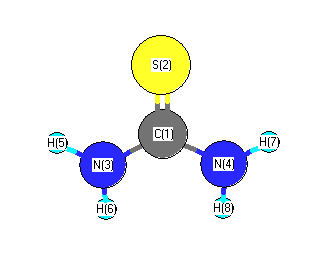Vibrational Frequencies calculated at B3LYP/cc-pVTZ
| Mode Number |
Symmetry |
Frequency
(cm-1) |
Scaled Frequency
(cm-1) |
IR Intensities
(km mol-1) |
Raman Act
(Å4/u) |
Dep P |
Dep U |
|---|
| 1 |
A |
3692 |
3569 |
19.60 |
|
|
|
| 2 |
A |
3565 |
3446 |
9.99 |
|
|
|
| 3 |
A |
1652 |
1597 |
69.20 |
|
|
|
| 4 |
A |
1411 |
1363 |
264.07 |
|
|
|
| 5 |
A |
1066 |
1030 |
63.92 |
|
|
|
| 6 |
A |
766 |
740 |
10.02 |
|
|
|
| 7 |
A |
498 |
481 |
27.03 |
|
|
|
| 8 |
A |
458 |
443 |
6.46 |
|
|
|
| 9 |
A |
342 |
331 |
123.67 |
|
|
|
| 10 |
B |
3691 |
3568 |
62.78 |
|
|
|
| 11 |
B |
3557 |
3438 |
42.48 |
|
|
|
| 12 |
B |
1627 |
1573 |
208.40 |
|
|
|
| 13 |
B |
1428 |
1380 |
94.56 |
|
|
|
| 14 |
B |
1070 |
1035 |
19.35 |
|
|
|
| 15 |
B |
641 |
619 |
8.49 |
|
|
|
| 16 |
B |
586 |
566 |
80.04 |
|
|
|
| 17 |
B |
399 |
386 |
5.46 |
|
|
|
| 18 |
B |
384 |
371 |
307.35 |
|
|
|
Unscaled Zero Point Vibrational Energy (zpe) 13416.0 cm
-1
Scaled (by 0.9666) Zero Point Vibrational Energy (zpe) 12967.9 cm
-1
See section
III.C.1 List or set vibrational scaling factors
to change the scale factors used here.
See section
III.C.2
Calculate a vibrational scaling factor for a given set of molecules
to determine the least squares best scaling factor.
Charges, Dipole, Quadrupole and Polarizability
Charges from optimized geometry at B3LYP/cc-pVTZ
Charges (e)
| Number |
Element |
Mulliken |
CHELPG |
AIM |
ESP |
| 1 |
C |
0.178 |
|
|
0.332 |
| 2 |
S |
-0.382 |
|
|
-0.404 |
| 3 |
N |
-0.214 |
|
|
-0.629 |
| 4 |
N |
-0.214 |
|
|
-0.618 |
| 5 |
H |
0.173 |
|
|
0.312 |
| 6 |
H |
0.143 |
|
|
0.351 |
| 7 |
H |
0.173 |
|
|
0.308 |
| 8 |
H |
0.143 |
|
|
0.347 |
Electric dipole moments
Electric dipole components in Debye
(What's a Debye? See section
VII.A.3)
| |
x |
y |
z |
Total |
| |
0.000 |
0.000 |
-5.026 |
5.026 |
| CHELPG |
|
|
|
|
| AIM |
|
|
|
|
| ESP |
0.009 |
0.002 |
-5.136 |
5.136 |
Electric Quadrupole moment
Quadrupole components in D Å
| Primitive |
|---|
| | x | y | z |
|---|
| x |
-34.415 |
1.585 |
0.000 |
| y |
1.585 |
-25.596 |
0.000 |
| z |
0.000 |
0.000 |
-29.145 |
|
| Traceless |
|---|
| | x | y | z |
|---|
| x |
-7.045 |
1.585 |
0.000 |
| y |
1.585 |
6.184 |
0.000 |
| z |
0.000 |
0.000 |
0.861 |
|
| Polar |
|---|
| 3z2-r2 | 1.722 |
|---|
| x2-y2 | -8.819 |
|---|
| xy | 1.585 |
|---|
| xz | 0.000 |
|---|
| yz | 0.000 |
|---|
|
Polarizabilities
Components of the polarizability tensor.
Units are
Å
3 (Angstrom cubed)
Change units.
| |
x |
y |
z |
| x |
4.173 |
-0.055 |
0.000 |
| y |
-0.055 |
7.217 |
0.000 |
| z |
0.000 |
0.000 |
9.954 |
<r2> (average value of r
2) Å
2
| <r2> |
101.655 |
| (<r2>)1/2 |
10.082 |
